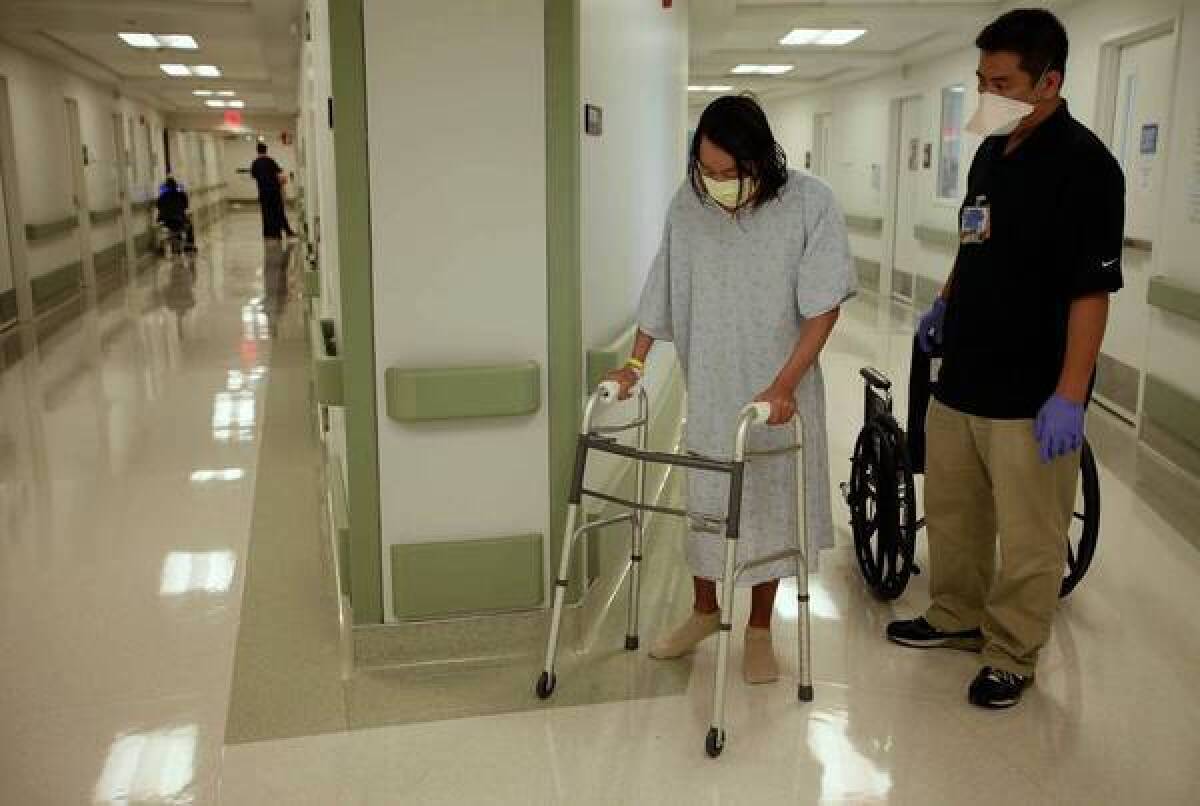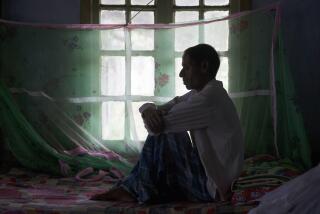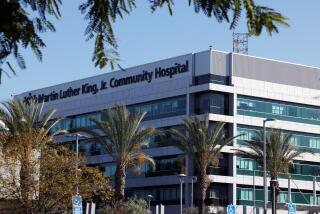TB is very much alive at Olive View-UCLA hospital in Sylmar

Matthew Kennedy spent his 39th birthday at the hospital learning to walk again.
Three months ago, the Venice Beach resident started having trouble moving his legs. When a chest X-ray at a Santa Monica health center revealed a shadow in his lungs, he was quickly transferred to a highly specialized tuberculosis ward 25 miles across the county at Olive View-UCLA Medical Center in Sylmar.
Doctors think the bacterial disease attacked his nerves — unusual for TB, which typically infects the lungs. But rare is normal for the Olive View unit, one of only four such centers in the nation specialized in tuberculosis. “Something that the average physician would only see maybe once in a lifetime, we see kind of routinely here,” said Dr. Glenn Mathisen, director of the infectious diseases department at Olive View.
The high-tech isolation unit opened last August as part of a $53-million federally funded renovation of the public hospital’s emergency room to equip it for a bioterrorism attack. For now, it serves highly infectious or difficult-to-treat tuberculosis patients, reflecting positive and negative crosscurrents in TB medicine: Infections are down dramatically but getting more complicated.
“You’re getting to those that are much more challenging to treat medically, that require longer hospitalization,” said Dr. Frank Alvarez, who directs the county’s tuberculosis control program.
For Olive View, which opened 90 years ago as the largest TB sanitarium west of the Mississippi, the new ward represents a bit of deja vu with a cutting edge. “We’ve come sort of full circle,” Mathisen said.
The facility, which can handle up to 30 patients, has a state-of-the-art, pressure-controlled air circulation system designed to keep the airborne disease from spreading. An alarm system sounds if anything is amiss, and air leaving the ward gets zapped with UV light to kill any tuberculosis germs.
Once known as consumption, the killer disease that claimed Emily Brontë and Frederic Chopin, tuberculosis is now viewed as a bygone threat by many in developed countries.
But the illness remains widespread in poorer countries and still surfaces in the United States in places like Los Angeles, with large and diverse immigrant communities. “It’s still a fatal disease,” said Alvarez. “It needs to be taken still very seriously in terms of public health and safety.”
TB cases in Los Angeles County have dropped nearly 70% over the last two decades. Still, 680 infections were confirmed last year and nearly 80% of those involved people born in other countries, primarily Mexico, the Philippines, Vietnam and China.
Olive View’s ward is designed to accommodate the most demanding cases, thereby freeing up beds in infectious disease wards at other county hospitals. Mathisen said the severity of the 68 tuberculosis cases that have come through the unit in the last year caught the staff by surprise. “They’re sicker than we thought they would be,” he said.
Many of the center’s patients are homeless or low income and have a host of other conditions that complicate tuberculosis treatment, including diabetes, HIV, heart disease, substance abuse or mental illness.
By keeping the patients for a few months, “we have time to counsel and educate them on their different illnesses” and medications, said Leona Mason, a nurse practitioner in the ward. “It’s a lot for some of these people to take on.”
People with weak immune systems are particularly at risk for tuberculosis, including children, the elderly and people with HIV. In Los Angeles, about 6% of tuberculosis cases occur among people with HIV, and nearly a quarter occur in people with diabetes.
Homeless patients or those with young children are required — by court order if necessary — to remain at Olive View until they are is no longer contagious. If a patient’s tuberculosis is resistant to first-line drugs, he or she may stay at Olive View to receive harsher medications that are more toxic and require closer monitoring.
Kennedy, who was adopted from Korea, contracted his infection as a child, but it remained dormant for decades. The disease emerged suddenly, taking him by surprise. Indeed, although about a third of the world’s population carries dormant tuberculosis, according to the World Health Organization, only about 10% of those infected will develop the disease.
In his hospital gown, tan socks and a paper face mask, Kennedy pushed a walker last week as he shuffled a lap around the hallways with the help of a physical therapist. He has improved significantly since arriving at Olive View three months ago, almost completely bedridden.
“I didn’t think it would do this to me,” Kennedy said, settling back into a wheelchair after his physical therapy session. Relearning to walk — something he always took for granted — has been his biggest challenge.
Recovering from tuberculosis can be a lengthy process. An infection that occurs only in the lungs takes a minimum of six months to fully treat. But infections in other organs — such as the brain or the bowels — other compounding illnesses or drug-resistance can require patients to take daily medication for as long as two years. Such factors can also drive up the cost of treatment from $25,000 to $250,000, Alvarez said.
Kennedy’s leg condition could require several more months to fully recover. In the meantime, he looks forward to seeing his friends who visit on the weekends.
It’s a hard way to spend a summer. “You look outside and it’s nice and sunny out, and I’m stuck in here,” he said.
More to Read
Start your day right
Sign up for Essential California for news, features and recommendations from the L.A. Times and beyond in your inbox six days a week.
You may occasionally receive promotional content from the Los Angeles Times.





